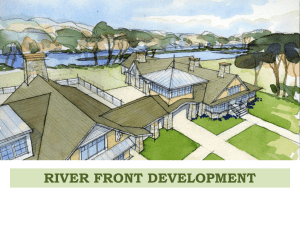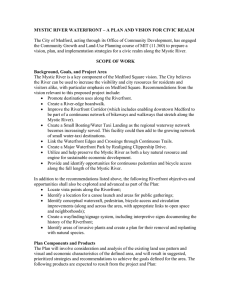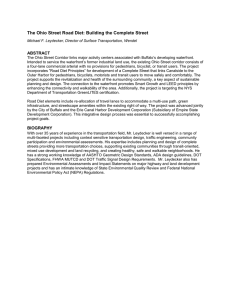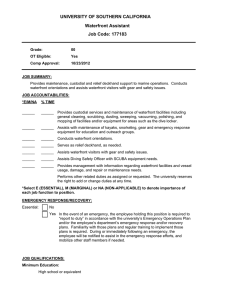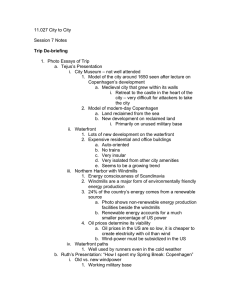THE EFFECTIVENESS OF THE RIVERFRONT DEVELOPMENT GUIDELINES IN MALAYSIA By
advertisement
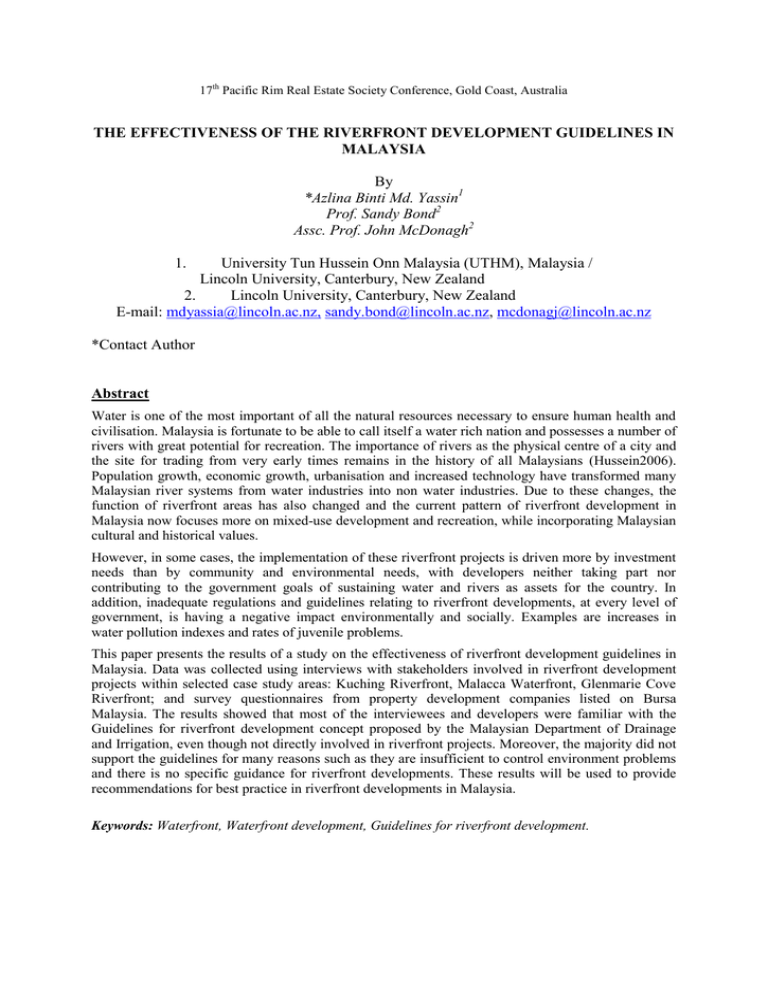
17th Pacific Rim Real Estate Society Conference, Gold Coast, Australia THE EFFECTIVENESS OF THE RIVERFRONT DEVELOPMENT GUIDELINES IN MALAYSIA By *Azlina Binti Md. Yassin1 Prof. Sandy Bond2 Assc. Prof. John McDonagh2 1. University Tun Hussein Onn Malaysia (UTHM), Malaysia / Lincoln University, Canterbury, New Zealand 2. Lincoln University, Canterbury, New Zealand E-mail: mdyassia@lincoln.ac.nz, sandy.bond@lincoln.ac.nz, mcdonagj@lincoln.ac.nz *Contact Author Abstract Water is one of the most important of all the natural resources necessary to ensure human health and civilisation. Malaysia is fortunate to be able to call itself a water rich nation and possesses a number of rivers with great potential for recreation. The importance of rivers as the physical centre of a city and the site for trading from very early times remains in the history of all Malaysians (Hussein2006). Population growth, economic growth, urbanisation and increased technology have transformed many Malaysian river systems from water industries into non water industries. Due to these changes, the function of riverfront areas has also changed and the current pattern of riverfront development in Malaysia now focuses more on mixed-use development and recreation, while incorporating Malaysian cultural and historical values. However, in some cases, the implementation of these riverfront projects is driven more by investment needs than by community and environmental needs, with developers neither taking part nor contributing to the government goals of sustaining water and rivers as assets for the country. In addition, inadequate regulations and guidelines relating to riverfront developments, at every level of government, is having a negative impact environmentally and socially. Examples are increases in water pollution indexes and rates of juvenile problems. This paper presents the results of a study on the effectiveness of riverfront development guidelines in Malaysia. Data was collected using interviews with stakeholders involved in riverfront development projects within selected case study areas: Kuching Riverfront, Malacca Waterfront, Glenmarie Cove Riverfront; and survey questionnaires from property development companies listed on Bursa Malaysia. The results showed that most of the interviewees and developers were familiar with the Guidelines for riverfront development concept proposed by the Malaysian Department of Drainage and Irrigation, even though not directly involved in riverfront projects. Moreover, the majority did not support the guidelines for many reasons such as they are insufficient to control environment problems and there is no specific guidance for riverfront developments. These results will be used to provide recommendations for best practice in riverfront developments in Malaysia. Keywords: Waterfront, Waterfront development, Guidelines for riverfront development. 1.0 INTRODUCTION In Malaysia from the earliest times, civilisations have been established along the banks of rivers. Rivers hold prominent places in human society. Settlements have historically sprung up along river banks, hence, many urban cities in Malaysia such as, Kuala Lumpur, Terengganu, Malacca, Kuantan, Kota Bharu and Kuching were established after waterfront settlements had developed - on river edges or in river valleys (Andaya & Andaya, 2001; Weng, 2005). As a consequence, some villages are named after the rivers that run through them, namely “Sungai Rengit, Sungai mati and Sungai Kapal in Johor (Yassin, Eves, & McDonagh, 2010a). After being abandoned for many years, Malaysia has begun to redevelop its waterfront areas, specifically along the river banks. Kuching city in Sarawak has been selected to initiate this project. The project known as Kuching Riverfront was proposed in 1989 by the Chief Minister of Sarawak, mainly for recreational purposes and permission for the development to proceed was granted in September 1993. The fully funded project by the State Government of Sarawak was then managed by the Sarawak Economic Development Corporation (SEDC) (Sarawak Economic Development Corporation, 1990). At present, many riverfront development projects have been undertaken throughout Malaysia, some were successful developments while others were not. In some cases, the implementation of these riverfront projects was driven more by investment needs rather than for community and environmental needs. Moreover, inadequate regulation for the control of riverfront development in this country (Yassin, Eves, & McDonagh, 2010b) has led Malaysia to suffer from environmental and social effects. This paper focuses on the respondents’ views of the riverfront development guidelines in terms of their effectiveness to control riverfront development in Malaysia. A sequential exploratory mixedmethod strategy was adopted in this research; a qualitative method followed by a quantitative method. A qualitative method by way of case study with one-to-one interviews and document reviews was used to investigate the relevant information about riverfront development practices in Malaysia. Information gathered was then included in the development of a questionnaire that was subsequently distributed to the property development companies in Malaysia. The purpose of the quantitative phase (questionnaire survey) was to confirm statistically the respondents’ evaluations about Riverfront Development Guidelines in an effort to improve riverfront development practices for Malaysia in the future. 2.0 LITERATURE REVIEW 2.1 Waterfront and Waterfront (Re) development In general, a waterfront is the zone of interaction between urban developments and the water and a waterfront area is considered as a unique and irreplaceable resource where it is the interface between 2 land, water, air, sun and productive plants (Wrenn, 1983). Moreover, Zhang (2002) characterised the waterfront as a place integrating land with water and having a natural attraction to people. In fact, the seashore and riverfront are the most attractive water features for human settlement and, in most countries, the land in front of water is developed earlier than the inland areas. Waterfront development refers to any development in front of water and a water body; a river, lake, ocean, bay, creek or canal (Breen & Rigby, 1994, p. 10). In the development area, Breen & Rigby (1996, 1994) considered that a waterfront development may not necessarily need to be directly fronting water but may only need to look attached to the water. They believe that commanding a view of water can still be considered as a waterfront property. In many cities in the world, waterfront areas began as commercial centres, transportation hubs and manufacturing centres, as a central focus for them. However, due to complex and multiple problems such as technology change, the historic preservation movement, increased environmental awareness and urban renewal, a dramatic change in waterfront areas was brought about and they became large spaces of unused property in the past thirty years or so (Breen & Rigby, 1994, p. 10). After decades of remaining abandoned, in the 1960s, massive waterfront redevelopment began and consequently initiated the world-wide era of waterfront revitalisation (Ryckbost, 2005). Urban waterfront redevelopment bloomed in the 1970s, accelerated in the 1980s (Breen & Rigby, 1994) and will continue in the future. Clearly, interest in promoting waterfront redevelopment in many countries was caused by environmental protection, shoreline access, water quality, historic preservation, tourism and economic development, as well as the growing potential of the waterfront for recreational, commercial and residential uses (Krausse, 1995). Moreover, festival and water sports are perhaps the most visible public-oriented activities that have played a key role in the rediscovery of waterfronts. 2.2 Waterfront and Waterfront Development in this Research In this research, waterfront development is used to represent such terms as waterfront revitalisation, waterfront rehabilitation and other terminologies. The word (re) development is only used when necessary; to differentiate between the redevelopment of previously built-up areas and new developments that are undertaken on a new development site. Waterfront development in this research refers particularly to any development in front of rivers. The exclusion of other waterfront development types, for example coastal development, is because, in Malaysia, the coastal zones are generally managed in a sectoral manner (J. Hussein, 2008; Zarin et al., 2001). This management approach is based on a tiered structure, between the Federal and State Government and Local Authorities. The governance in each level of government is responsible for their own management roles, which include performing planning and coordination, implementation and enforcement, and development roles within their jurisdictions. 3 2.3 Waterfront Development in Malaysia Waterfront development in Malaysia emerged after the growth of societies along the river edges and this subsequently initiated the emergence of port towns and several other urban forms (Yassin et al., 2010a). During that time, waterfront areas were the busiest places to cater for business and trading, and these further transformed waterfront areas into focal points for Malaysians. After gaining independence in 1957, Malaysia struggled to achieve urbanisation, focusing more on infrastructure development. Moreover, the experience of rapid development and urbanisation over decades caused the state government to start including many riverfront areas in future development, focusing more on recreational use, while private developers concentrated more on mixed-use development. The Kuching Riverfront, Malacca Waterfront, Glenmarie Cove Riverfront and Kingfisher Cove Riverfront (to name a few) are examples of development projects that applied these mixed-use waterfront redevelopment phenomena in Malaysia. To date, interest in waterfront properties is booming, even when at high prices, as people want to live close to the water for recreational and aesthetic reasons. However, in some cases, the implementation of these waterfront projects is driven more by investment needs than by community and environmental needs, with developers neither taking part nor contributing to the government goals of sustaining water and rivers as an asset for the country. In addition, inadequate regulations and guidelines relating to waterfront development, at every level of government, is having a negative impact environmentally and socially. Examples are, increases in water pollution indexes and rates of social problems. Therefore, this research aims to bring a new vision of waterfront development by incorporating economic development goals with community goals and the government’s desire to achieve successful waterfront development practices. Incorporating the environmental, economic and social aspects with flexible regulations for waterfront development are ways to develop successful waterfront development practices that will benefit the population and, subsequently, enhance the economic success of waterfront locations. 2.4 Principles for Sustainable Waterfront Development Waterfronts are one of the most valuable resources for a country – being limited, precious and nonrenewable assets. To secure long-term growth of this resource, it is important for waterfront areas to be used strategically to maintain their economic value and enhance their specific features or image (Bruttomesso, 2006). For this reason, Bruttomesso (2006) recommended 10 principles to achieve excellence in waterfront redevelopment projects, as presented in Table 1 below. 4 Table 1: Principles for sustainable waterfront development Secure the quality of water and the environment. Ten principles for a sustainable waterfront development Waterfronts are part of the existing urban fabric. The historic identity gives character. Mixed-use is a priority. Public access is a prerequisite. Planning in public-private partnerships speeds the process. Public participation is an element of sustainability. Waterfronts are long term projects. Revitalisation is an ongoing process. Waterfronts profit from international networking. (Source: Bruttomesso, 2006) Therefore, in waterfront developments, maintaining and enhancing the benefits derived from the development is a challenge. Thus, it follows that a set of principles to guide the project is important and recommended, to achieve the goal of the development. Regulations and Guidelines Related to Waterfront Development in Malaysia 2.5 In most countries, various forms of regulations were implemented to correct physical, economic, social and spatial imbalances (Singh, 1994). In Malaysia, legislative systems were implemented within a broader framework and supervised by the federal government. According to Hashim (2009), laws were also used as a form of management in response to environmental problems in Malaysia. Table 2 summaries related laws, policies and guidelines to the waterfront development in Malaysia according to the years. Table 2: Related law,Policies and Guidelines related to the waterfront developments in Malaysia Year Law 1907 Sanitary Boards Enactment. 1913 Municipal Ordinance Cap 133/1913 1920 Water Act 1920 (Act 418). 1923 Town Planning and Development Bill, 1923. 1927 Town Planning and Development Bill, 1927. 1930 Sanitary Boards Enactment Cap 137, 1930. 1953 Irrigation Areas Act 1953 (Act 386). 1955 Town Boards Enactment of the Federated Malay Policy/Guideline States (Cap 137) amended in 21st April 1955. 5 1958 Undang-undang kecil Bangunan Dewan Bandaraya Kuala Lumpur 1958. 1960 Akta Ibu Kota Persekutuan 1960 (Act 190). 1964 Land Conservation Act 1965 National Land Code 1965 (Act 65). 1974 Environmental Quality Act 1974. 1974 Street and Drainage Act 1974. 1974 Federal Constitution. 1976 Local Government Act 1976. 1970s City of Kuala Lumpur (Planning) Act 1973 (Act 107). 1976 Town and Country Planning 1976. 1982 Federal Territory (Planning) Act 1982 (Act 267). 1984 Kuala Lumpur Structure Plan 1984. 1985 1986-1990 Fisheries Act 1985 (Act 317). 5th Malaysia Plan. 1991-1995 6th Malaysia Plan. 1996-2000 Kuala Lumpur Structure Plan 2020. 7th Malaysia Plan. National Environmental Policy. National Physical Plan. 8th Malaysia Plan. 2001-2005 2005 2005 National Heritage Act 2005 (Act 645). River Reserves (JPBD). Konsep Pembangunan Menghadap Sungai (JPS). 2005 Waterfront as Recreational Area. 2006 National Urbanisation Policy. 2006-2010 9th Malaysia Plan. 2008 Draft Local Plan 2020. 2010 10th Malaysia Plan. 6 (Source: Latip, Heath, Shamsuddin, Liew, & Vallyutham, 2010) 2.5.1 Guideline for the development related to rivers and river reserves The guidelines for the development related to rivers and river reserves were designed by the Department of Drainage and Irrigation, Malaysia (2006b). Guidelines for the development related to river and river reserves was developed specifically for Local Authority,1 to provide guidance and to facilitate them in decision for land development planning approval of river and river reserves and including riverfront development. This guideline also include all information and scope of impact assessment that required for any developments that involve of river reserve and river itself, as well as flow chart of development approval process. The guideline for riverfront development concept was designed and proposed concurrently with the guidelines for the development related to river and river reserves (Malaysian Department of Drainage and Irrigation, 2006a). The guideline for riverfront development concept was developed for Local Authority uses as a reference for planning of development close to river areas. In addition, this guideline is also necessary as reference for developers and consultant uses that are directly and/or indirectly involved in the development close to the river areas. Specifically, the guideline for riverfront development concept aims four objectives, as follows: (a) To explain and encourage the implementation of guideline in the development planning of riverfront areas. (b) To be a reference and a guideline for any development near to the river areas. (c) To provide uniform guidelines for all parties involved in the riverfront development process. (d) To control all types of riverfront developments. According to the guidelines for riverfront development concept, planning for riverfront development is required to include neighbourhood areas within 50 meters from a river reserve and the river body itself. This is not considering the land status and/or land type of the development areas. The guidelines proposed several criteria that could guide and should be taken into consideration while planning for development in front of river areas. Table 3 summarises and presents the criteria proposed for guidelines of riverfront development. 1 Land administrator and Local Authority are responsible parties involve in land development planning approval, and including development planning for river and river reserves. 7 Table 3: Criteria for guidelines of riverfront development concept No. 1. Criteria River as a main attraction of development Description According to the guideline, for any reason, river’s role is remaining as a main attraction for the development. River itself must be developed earlier than any others development planning. Removal and changing river line or row are not permitted. 2. Beautification of river reserves According to the guideline, developers are required to provide recreation and beautification plan for river reserves and been approved by Department of Drainage and Irrigation, Malaysia. Maintaining river reserve as a buffer zone to control environmental problem such as soil erosion. Utilisation river reserve for green areas and recreational use are allowed to the developers. 3. Level of river flow According to the guideline, a development close to river areas would not increase level of river flow. Development are more than 10 ha are required to built retention pond with maximum area approximately between 3-5% of total development area. 4. Development of According to the guideline, the development of permanent building and infrastructure are not allowed within river and river reserves, unless facilities for recreational purposes such as play ground. permanent infrastructure 5. Platform level of building 6. Riverfront development concept 7. River view River beautification work that could increase river’s water flow must obtain approval from Department of Drainage and Irrigation. According to the guideline, maximum platform level for building is required to reduce any damage from flooding. According to the guideline, planning for development close to river area must include the riverfront development concept. Main access of building must facing to river. Property developers are responsible to undertake beautification work for the development close to river area, and contributing a portion of maintenance cost for river reserve and beautification works to Local Authority. According to the guideline, the development planning of riverfront areas should concern on the river view. The arrangement of building type and size is required in proposed development plan. 8. Open space According to the guideline, any planning for infrastructure development is highly required to maintain and conserved open space along the river. 9. Public access According to the guideline, gated and any activities which not allow public access to the river and their reserve are prohibited. 10. Conservation of According to the guideline, development close to river areas is requires to maintain the green zone along the river reserves as habitat 8 flora and fauna for flora and fauna. Construction of concrete structure along the river banks is limited and forest tree with high commercial value are not allowed to harvest and cut. 11. Recreation activities 12. Preservation of historic value of river 13. Water restoration According to the guideline, recreation activities that involve river such as fishing and kayak is highly encouraging. According to the guideline, maintaining and preserving the historic value of river and including historical building along the river is required. According to the guideline, centralise sewage system for the development along the river areas is required. Treatment is needed before discharged to rivers to avoid water pollution. This requirement is compulsory for development project more than 10 hectares. 14. Bridge A bridge facility with good design and high standard quality is required to facilitate people access to this area. The wide of the bridge is 4.5 meter for river banks and using the elevated bridge or arch bridge type. (Source: Malaysian Department of Drainage and Irrigation, 2006a) In order to maintain the success of riverfront developments concept, the guideline for riverfront development concept is recommended to be applied in conjunction with other regulations as follow: 1. Water Act 1920 (Amendment 1989); 2. Local Authority Act 1976 (Act 171); 3. Environment Quality Act 1974 (Act 127); 4. Mining Enactment 1962 (F.M.S. Cap. 147); 5. Drainage Works Act 1954 (Act 354) (Amendment 1989); 6. Irrigation Areas Act 1953 (Act 386) (Amendment 1989); 7. Road, Drainage and Building Act 1974 (Act 133); 8. National Land Code 1965 (Act 56); and 9. Other regulations that enforced from time to time. Application of the guidelines of riverfront development concept would facilitate all parties that directly and/or indirectly involve in the riverfront development, and would encourage riverfront development concept for future development in Malaysia. 9 3.0 RESEARCH METHODS A mixed methods research strategy – sequential exploratory mixed method strategy, that comprised a qualitative approach, followed by a quantitative approach, was employed in this study. The qualitative phase in this study was a case study, and was followed by a survey questionnaire in the second phase (quantitative approach). The significance of qualitative research, in general, is to explore new phenomena and to understand complexities that focus on the provision of in-depth information. The emphasis of the case study approach, in particular, in relation to this research was to examine riverfront development guidelines in Malaysia from the waterfront development stakeholders’ point of view. In this study, three case study areas were selected; namely, Kuching Waterfront in Sarawak, Malacca waterfront in Malacca and Glenmarie Cove Riverfront in Selangor. A judgemental sampling method was adopted as a sampling procedure for selecting respondents in the qualitative phase (interviews) in this research. This was because the primary consideration in judgemental sampling was the judgement of who can provide the best information in order to fulfil the objectives of the research. Therefore only those people who were likely to have the required information, knowledge and willingness to share it were interviewed (Kitchin & Tate, 2000). All respondents were included to aid a better understanding of waterfront development in Malaysia. The semi-structured nature of qualitative research is flexible. While the interviewer generally has guidelines to explore, new questions can be brought up during the interview as a result of what the interviewee says. The data collection also included the analysis of documents related to the selected case study areas. Documentary evidence acted as a method to cross-validate information gathered from interviews, which was sometimes different (what people say was sometimes different from what people do). Thus, the integration of multiple qualitative techniques from the case study research enhanced the validity and reliability of the findings from this research. Information gathered from the interviews and the identified attributes were then included in a survey questionnaire. The purpose of the quantitative approach (questionnaire) in this research was to confirm statistically the interview results. These results will then be used to give recommendations for best practices for waterfront developments in Malaysia. For the quantitative approach, the sample data comprised firms listed under the property counter that traded at Bursa Malaysia during 2009. A stratified sampling procedure was used as part of probabilistic sampling (Sapsford & Jupp, 2006; Sekaran, 2003). This sampling procedure was considered to be the most popular procedure in survey research, allowing the researcher to group the sample based on specific variables such as financial status and company profile. The percentage of each sub-group in the entire population was maintained in the sample. Furthermore, a stratified 10 sampling technique was a more representative, time saving and economic means to obtain a sample from the population (Newman & McNeil, 1998). For this reason the strengths of both qualitative (identification of new considerations) and quantitative methods (confirmation of the statistical significance of newly identified considerations) were combined in order to provide more robust and comprehensive results. The use of multiple methods within a single study offered wide perspectives and more extensive results through the combination of a variety of data sources (Creswell, Clark, Gutmann, & Hanson, 2003, p. 211; Morse, 2003, p. 195; Tashakkori & Teddlie, 2003, p. 16). 4.0 RESULTS AND DISCUSSION This section presents the results derived from the exploratory analysis, and results from the statistical analysis. 4.1 Qualitative Results 4.1.1 Response Rate Interviews were sufficiently well answered to allow a response rate of 100 percent to be obtained. A total of 25 face-to-face interviews were conducted within the 10 weeks from the 10th of May to the 20th of July 2009. Input was obtained from three different sources; (i) Government officers; (ii) Private property developers; and (iii) Waterfront community. Table 4 presents information about the interviewees who participated in the interviews. Table 4: Composition of the Interviews Organisation Number of Interviewee Percent (100) Federal Government 3 12 State Government 5 20 Local Authority 10 40 Private Sector 2 8 Waterfront community 5 20 TOTAL = 25 4.1.2 Regulations Associated with Waterfront Development in Malaysia In regard to regulations associated with waterfront development in Malaysia, all 25 interviewees were asked for their opinions about this, as follows: Q: Based on your knowledge, what are the regulations associated with waterfront development in Malaysia? From the interviews, all respondents felt that waterfront developments require similar regulations as those enforced for any land development in Malaysia. From the interviews, they also suggested several 11 regulations could be associated with waterfront development in Malaysia, as presented in Table 5 below. Table 5: Regulations associated with waterfront development in Malaysia Regulations Respondent Percentage (%) National Land Code, 1965. G1, G2, G3, G4, G10, G13, G14, G16, G18, P25 40 Land Acquisition Act 1960. G1, G4, G7, G13, G15, D19, P1, P2 32 Act 127 in Environmental Quality Act 1974. G1, G2, G3, G6, G16, G18, P2, P3 32 Uniform Building by Laws 1984. G1, G2, G4, G14, D20,D21, P25 28 Urban Planning Act 1974. G1, G6, G14, G15, G16, D19 24 Coastal Zone guidelines. G2, G3, G11, G17, P1, P3 24 Act 171 in Local Authority Act 1976. G7, G15, G16, D19 16 Riverfront Development Guidelines. G2, G3, G16, P1 16 Act 133 in Street, Drainage & Building Act 1974. G4, G15, D20, P5 16 National Landscape Guidelines G6, G8, G17, P2 16 From the interviews, 10 regulations and guidelines were identified as being associated with waterfront development in Malaysia. From the results, 40% of respondents felt that the National Land Code, 1965 was the most relevant regulation for waterfront development in Malaysia. This was followed by the Land Acquisition Act and the Environmental Quality Act, which accounted for 32% each. Table 5 lists the regulations and guidelines associated with waterfront development, as suggested by the interviewees. Next, all 25 respondents were asked further questions about Riverfront Development Guidelines, as follows: Q: The guidelines for riverfront development concept are designed mainly to control development in front of water areas, particularly close to river areas. Are you aware of these guidelines? From the interviews it appeared that the majority of respondents (about 84%) were aware of Guidelines for riverfront development concept, while the rest (about 26%) were not familiar with these guidelines. The 84% of respondents who were aware and familiar with the guidelines were then asked about the sufficiency of these guidelines for the control of waterfront development in Malaysia. Q: Are these guidelines considered effective towards successful riverfront development projects? From the interviews it appeared that only 14.3% thought that the guidelines for riverfront development concept were sufficient to control waterfront development in Malaysia, and the majority of them (about 85.7%) thought these guidelines were not sufficient for the control of waterfront development in Malaysia. Moreover, from the interviews, the respondents thought that Malaysia had inadequate 12 regulations for waterfront development and in fact it seemed there were no specific regulations designed for waterfronts. The guidelines for riverfront development concept designed by government bodies were apparently not enforced by the state. Table 6 summarises the results. Table 6: the guidelines for riverfront development concept – effectiveness level Frequency (%) Are you aware of the riverfront development guidelines? Yes 21 (84) Not familiar 4 (26) Frequency (%) Are these guidelines considered effective for successful riverfront development projects? Sufficient 3 ( 14.3) Not sufficient 18 (85.7) The 85.7% who indicated that the guidelines for riverfront development concept were not sufficient to control waterfront development in Malaysia were then asked the reasons behind their opinions. Table 7 summarises the responses from the respondents. Table 7: Guideline for riverfront development conce[t – reasons for ineffective guidelines Reasons for not being effective n = 18 (%) Ranking Insufficient to control environmental issues. 10 (56) 1 Insufficient to encourage sustainable waterfronts. 8 (32) 2 Too general and do not provide specific guidance. 7 (39) 3 Difficult to implement in practice. 3 (16) 4 As presented in Table 7 above, more than half (56%) of the respondents who indicated that guidelines for riverfront development concept were not sufficient to control waterfront development in Malaysia, identified insufficient control of environmental issues as the most influential reason for not being effective guidelines. Moreover, 32% of respondents identified that these guidelines were not effective due to their being unable to encourage sustainable waterfront developments. A few respondents (16%) indicated that difficulty in implementing these guidelines in practice was also a reason. Table 7 above, summarises the results. 4.2 QUANTITATIVE RESULTS The information gathered from the interviews (qualitative phase) were then included in a questionnaire used in a survey of property developers in Malaysia. Of the 91 questionnaires mailed and e-mailed to the respondents, 61 were returned within the three months of the response period (the survey was conducted within April to July, 2010). This resulted in a total of 67% useable response rate. Only valid 13 responses were reported in this research. The 67% response rate obtained was considered a high response rate for this type of postal/e-mail survey, given that a typical response rate would be 30% (Sekaran, 2003, p. 251). 4.2.1 Profile of Property Development Companies Profiles of the property development companies who participated in the survey questionnaire in this research are presented in Table 8 below. Table 8: Profiles of the respondents Variable Location of operations Year of operating Number of employees Type of development projects Detail n = 61 Percent (%) National (within Malaysia) 49 80.3 International (outside Malaysia) 0 0 Both national and international 12 19.7 Below 1 year 0 0 2 - 5 years 0 0 6 – 10 years 4 6.6 Over 10 years 57 93.4 0 – 10 people 0 0 11 – 50 people 6 9.8 51 – 100 people 10 16.4 Over 100 people 42 68.9 Do not know / Not sure 3 4.9 Residential: Yes 61 100 Commercial: Yes 53 86.9 No 8 13.1 Yes 25 41 No 36 59 Yes 7 11.5 No 54 88.5 Industrial: Others: As presented in Table 8, 80.3% of the property development companies operated within Malaysia while 19.7% operated at both the national and international level. None of the companies operated only at the international level. The majority (93.4%) of property development companies participating in this survey have operated their companies for over 10 years and a mere 6.6% operated them for between six and nine years. None of the property development companies have operated for less than five years. Moreover, more than half (68.9%) of all the property development companies participating in this research employed over 100 workers. Around 16.4% employed between 51 and 100 workers while a 14 further 9.8% employed between 11 and 50 workers. Not surprisingly, no companies employed fewer than 10 workers. Companies participating in this research were involved in several property development activities; residential, commercial, industrial and recreational. In particular, all companies actively participated in residential development, followed by 86.9% active in commercial development activities while only 41% were active in industrial development. Only 11.5% were involved in other development activities such as recreational. From the results, it appeared that the respondents represented in the sample had quite similar profiles. They were property developer companies that had been actively practising property development for many years and they were listed in Bursa Malaysia. 4.2.2 Level of awareness about waterfront development regulations A question was included to determine the respondents’ level of awareness of the various regulations that related to waterfront development in Malaysia. Overall, the result indicated that the majority of respondents were somewhat familiar with the regulations related to waterfront development in Malaysia. The mean score for each regulation is presented in Table 9 below. The results showed that the respondents were most familiar with the National Land Code, 1965 (mean=3.59). The Urban Planning Act, 1974, the Building by Law, 1984, the Land Acquisition, 1960 and the Local Authority Act, 1976, were more familiar to respondents with mean scores greater than 3.50. The results showed that the lowest mean score was the guidelines for riverfront development concept (mean=3.05). However, respondents were still familiar with these guidelines. Table 9: Regulations and guidelines for waterfront development - respondents’ level of awareness Regulation Mean scores Ranking National Land Code 1965. 3.59 1 Urban Planning Act 1974. 3.57 2 Uniform Building by Law 1984. 3.56 3 Land Acquisition Act 1960. 3.52 4 Local Authority Act 1976. 3.51 5 Environment Quality Act 1974. 3.48 6 Street, Drainage and Building Act1974. 3.38 7 Coastal zone development guidelines. 3.16 8 National Landscape guidelines. 3.16 9 Guidelines for riverfront development concept 3.05 10 Average mean score = 3.40 * Scale: from Never heard of it = 1 to Very familiar = 4 15 4.2.3 Sufficiency of waterfront development regulations To determine the concern respondents have about the sufficiency of the regulations (as listed in Table 9 above) for the control of waterfront development in Malaysia, four options were provided, as outlined in Table 10 below. Table 10: Regulation sufficiency for waterfront development Option Frequency (%) Too many regulations. 4 (6.6) Insufficient regulation. 27 (44.3) Moderately sufficient - could do more. 23 (37.7) Sufficient regulation - no change needed. 7 (11.5) Results showed that nearly half (42.6%) of respondents determined that Malaysia did not have sufficient regulations to control waterfront development. About 37.7% of respondents agreed that the government had provided regulations for waterfront development but only to a moderate extent. In contrast, only 6.6% of respondents thought that there are too many regulations and that these were sufficient to control waterfront development, while another 11.5% of respondents felt that Malaysia had sufficient regulations for waterfront development and that no change was needed. This indicated that perhaps the government and the policy makers might need to improve regulations for waterfront development. 4.2.4 Enforcement of waterfront development regulations From a range of options, as listed in Table 11 below, more than half (52.2%), suggested that the Malaysian government moderately enforced the regulations for waterfront development in Malaysia. About 24.6% felt that no enforcement was undertaken by the responsible agencies. In contrast, 3.3% of respondents felt that the regulations had been enforced strictly while the remaining 19.7% were unsure about whether the regulations were enforced or not. This indicated that perhaps the Malaysian government and the responsible agencies might need to strictly enforce the regulations for waterfront development. Table 11 summarises the responses about the enforcement of waterfront regulations in Malaysia. Table 11: Enforcement of regulations for waterfront development Option Strictly enforced. Frequency (%) 2 (3.3) Moderately enforced. 32 (52.2) Not enforced. 15 (24.6) Unsure. 12 (19.7) 16 4.2.5 Effectiveness of the Riverfront Development Guidelines In terms of the effectiveness of the guidelines for riverfront development as a guideline to control waterfront development in Malaysia, four factors previously suggested by the interviewees in the first phase of data collection were assessed, as outlined in Table 12 below. Table 12: Effectiveness of Riverfront development guidelines Reasons for not being effective Mean scores Ranking Sufficient to control environment problems. 2.25 1 Provide specific guidance for riverfront development. 2.43 2 Easy to implement the guidelines in practice. 2.43 3 Encourage sustainable riverfront development. 2.57 4 Average mean score = 2.42 * Scale: from strongly disagree = 1 to strongly agree = 5 Overall, the results indicated that majority respondents disagreed about the effectiveness of the guidelines for riverfront development concept, with average mean scores 2.45. The means value for each factors is range between 2.25 and 2.57, indicating that the respondents disagreed about effectiveness of the guidelines for riverfront development concept to control waterfront development in Malaysia. For example, the respondents disagreed that the guidelines was sufficient for control environmental problems (mean scores=2.25) that could be derived from the waterfront development areas and guidelines for riverfront development concept was also identified as did not provide specific guidance (mean scores=2.43) for waterfront development in Malaysia. The responses for effectiveness of guidelines for riverfront development concept are summarised in Table 12 above. 5.0 CONCLUSION This paper aimed to explore the effectiveness of guidelines to control riverfront development in Malaysia. The statistical results confirmed that the developer’s level of awareness of the regulations, which directly or indirectly relate to the control of riverfront developments was high. The majority indicated that they were somewhat familiar with the regulations. Nevertheless, bear in mind, some regulations were designed specifically for certain states, and some may be not necessary to others. Moreover, the results showed that Malaysia does not currently have sufficient regulations and guidelines to control riverfront development. The existing regulations enforced for land development in Malaysia were considered efficient to control land use issues such as; (i) The canon - National Land Code (1965), (ii) Compulsory purchase and compensation - Land Acquisition Act (1960), and (iii) Planning and related development regulations – the Environmental Quality Act 1974, (Omar & Yusof, 2002), but in terms of riverfront development, it was quite inadequate. The guidelines for riverfront development concept designed by the Department of Drainage and Irrigation failed to achieve their 17 objectives due to several limitations such as they are difficult to implement in practice and are insufficient to encourage sustainable waterfront development. More than that, the failure of the Malaysian government and the responsible institutions, specifically to enforce the regulations and guidelines, has resulted in unsuccessful waterfront developments in this country. Therefore, in order to strengthen regulations and guidelines for waterfront developments in Malaysia, the government and the policy makers are required to do more with the regulations in the future. In this research, the researcher has also identified several components that should be included in waterfront development guidelines in an effort to practice waterfront developments in a good manner. This will be discussed in another paper. Improvement is required in order to enhance and maintain sustainable waterfront developments in the future, in this country. 6.0 REFERENCES Andaya, B. W., & Andaya, L. Y. (2001). A history of Malaysia (Second ed.). Hampshire, Britain: Palsgrave Breen, A., & Rigby, D. (1996). The new waterfront: A worldwide urban success story. New York: McGraw-Hill. Breen, A., & Rigby, D. (Eds.). (1994). Waterfronts: Cities reclaim their edge. United State: McGrawHill, Inc. Bruttomesso, R. (2006). Waterfront development: A strategic choice for cities on water. Paper presented at the Waterfront Development Forum: China Maritime (02 March 2006), Hong Kong. Creswell, J. W., Clark, V. L. P., Gutmann, M. L., & Hanson, W. E. (2003). Advanced mixed-methods research designs. In A. Tashakorri & C. Teddlie (Eds.), Mixed methods in social & behavioral research (pp. 209-240). Thousand Oaks, California: Sage Publications, Inc. Daud, H. (2009). Legislative approach to water quality management in Malaysia: success and challanges. Malaysia: Department of Environment, Ministry of Natural Resources and Environment. Hussein, H. (2006). Urban recreational riverfronts: Successful revitalisation elements. Journal of Design and the Built Environment, 2 (1). Hussein, J. (2008). Opportunities and challenges in sustainable construction. Paper presented at the International Conference and Expo on Environment Management and Technologies (ICEEMAT 2008) on (10 - 12 December 2008), PWTC, Kuala Lumpur. Kitchin, R., & Tate, N. J. (2000). Conducting research in human geography: Theory, methodology and practice. Harlow: Prentice Hall. Krausse, G. H. (1995). Tourism and waterfront renewal: Assessing residential perception in Newport, Rhode Island, USA. Ocean and Coastal Management, 26(3), 179-203. Latip, N. S. A., Heath, T., Shamsuddin, S., Liew, M. S., & Vallyutham, K. (2010). The contextual integration and sustainable development of Kuala Lumpur's city centre waterfront: An evaluation of the policies, law and guidelines. Paper presented at the The World, Engineering, Science and Technology Congress (ESTCON 2010) (15-17 June 2010), Kuala Lumpur Convention Centre, Malaysia. Malaysian Department of Drainage and Irrigation. (2006a). Guidelines for riverfront development concept. Department of Drainage and Irrigation, Ministry of Natural Resources and Environment. Malaysian Department of Drainage and Irrigation. (2006b). Guidelines for the development related to river and river reserves. Kuala Lumpur, Malaysia: Department of Drainage and Irrigation. Morse, J. M. (2003). Principles of mixed-method and multi-method research design. In A. Tashakorri & C. Teddlie (Eds.), Handbook of mixed method in social and behavioral research (pp. 189207). Thousand Oaks, California: Sage Publication, Inc. 18 Newman, I., & McNeil, K. (1998). Conducting survey research in the social sciences. Lanham, Maryland: University Press of America. Omar, I., & Yusof, A. M. (2002). Indigenous land rights and dynamics of the land market in Kuala Lumpur, Malaysia. Habitat International, 26, 507-521. Ryckbost, P. (2005). Redeveloping urban waterfront property. USA: University of Michigan. Sapsford, R., & Jupp, V. (2006). Data collection and analysis. London: SAGE Publications. Sarawak Economic Development Corporation. (1990). Kuching Riverfront Master Plan. Sarawak, Malaysia: Sarawak Economic Development Corporation. Sekaran, U. (2003). Research methods for business: A skill building approach (4th edition ed.). New York, NY: John Wiley & Sons. Singh, G. (1994). UMP - Asia Occasional Paper: Lands laws, land policies and planning in Malaysia: Urban Management Programme Regional Office for Asia – Pacific (UMP – Asia). Tashakkori, A., & Teddlie, C. (2003). Mixed methods in social and behavioral research. California: SAGE Publications Incorporated. Weng, C. N. (2005). Sustainable management of rivers in Malaysia - Involving all stakeholders. International Journal River Basin Management, 3(3), 147-162. Wrenn, D. M. (1983). Urban waterfront development. Washington, D.C.: The Urban Land Institute. Yassin, A. M., Eves, C., & McDonagh, J. (2010a). An evolution of waterfront development in Malaysia. Paper presented at the 16th Pacific Rim Real Estate Society Conference (24-27 January 2010), Intercontinental Hotel, Wellington, New Zealand. Yassin, A. M., Eves, C., & McDonagh, J. (2010b). Waterfront development in Malaysia: Do we have sustainable governance? . Paper presented at the PhD. Colloqium Program for 16th Pacific Rim Real Estate Society Conference (24-27 January 2010) Intercontinental Hotel, Wellington, New Zealand. Zarin, D. J., Pereira, V. F. G., Raffles, H., Rabelo, F. G., Pinedo-Vasquez, M., & Congalton, R. G. (2001). Landscape change in tidal floodplains near the mouth of the Amazon River Forest Ecology and Management, 154(3), 383-393. Zhang, L. (2002). An evaluation an urban riverfront park, Riverfront Park, Spokane, WashingtonExperience and lessons for designer. Unpublished master thesis, Washington State University, United States. 19
